

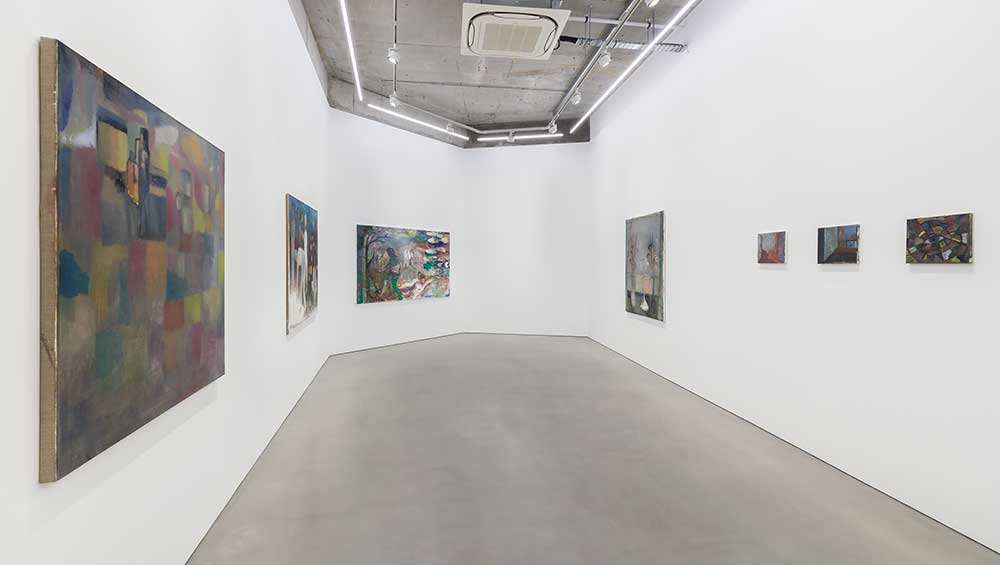
Behrang Karimi: Dinge Weltweit. Exhibition view, Maureen Paley, London, 2023. © Behrang Karimi, courtesy Maureen Paley, London. Photo: Mark Blower.
Maureen Paley, London
21 January – 5 March 2023
by TOM DENMAN
In this often-fascinating show, taking place at both Maureen Paley’s London spaces, Behrang Karimi operates in two distinct modes. On the one hand, the Iranian-born, Cologne-based painter’s works are small, fragmentary and opaque. Most of these paintings are no larger than 50cm across. Otherwise, he works within significantly larger, though nonetheless domestic, proportions, staying under 200cm in either height or breadth. There is no evidence of an in-between mode, and the small and the large are notably different in how they affect the viewer.
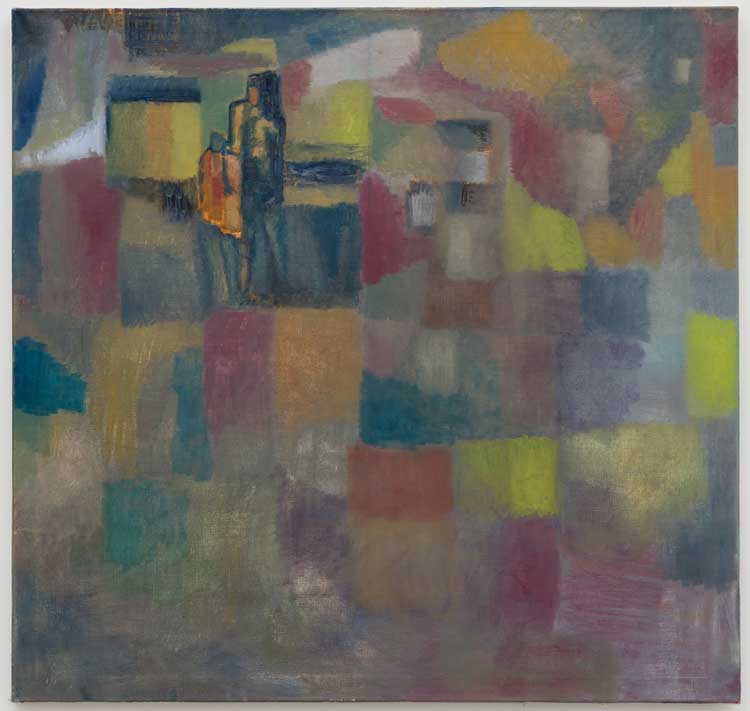
Behrang Karimi. o.T., 2020. Oil on linen, 115 x 120 cm (45 1/4 x 47 1/4 in). © Behrang Karimi, courtesy Maureen Paley, London
Photo: Mark Blower.
The main gallery, in Bethnal Green, includes large and small works in roughly equal measure. In o.T. (2020), one of his larger canvases, what at first strikes as a gridded patchwork of muted pinks and earth tones disintegrates into formlessness. The immediate consistency of the whole is rendered inconsistent with time. As the details take form, shapes proliferate, mutate and merge; colours blend and become muddy. The blotch in the top left quarter transforms into a pair of figures, an adult and a child perhaps, or maybe there are three. Like many of Karimi’s better works at this scale, and like much good painting, this one has the contradictory effect of becoming stranger the longer the eye lingers on it. Like a timeworn wall, it is full of passages that act as fragments in the making.
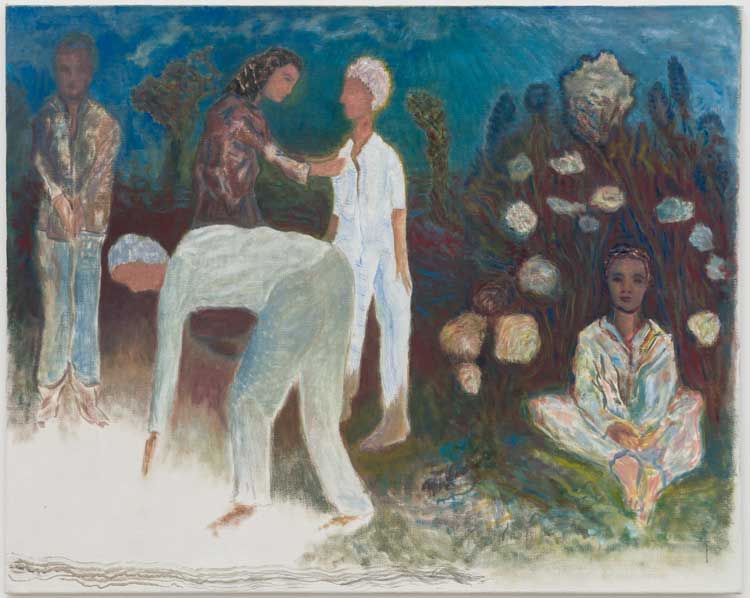
Behrang Karimi. Awakening in a dream, 2021. Oil on linen, 120 x 150 cm (47 1/4 x 59 in). © Behrang Karimi, courtesy Maureen Paley, London. Photo: Mark Blower.
Awakening in a Dream (2021) and Search of a Bird (2022) are among the show’s largest and most populous works. The former includes five figures in a swirling, nocturnal blue-green landscape. One sits within a tentlike plant, haloed by flowers. Another bends down and reaches towards a bright white pond, while the figure behind them (in this work at least, gender is ambiguous) is dressed in bright white clothing, perhaps having emerged from this brightness, which could be magical or sacred. In search of a bird, figures swim amid waterlilies. In the distance, others stand, perhaps beside the pond. Another figure, who could have emerged from the pond, theatrically holds his hand out to a tree, as if expecting something to fall into his palm, unless something is falling into his palm that we cannot quite see.
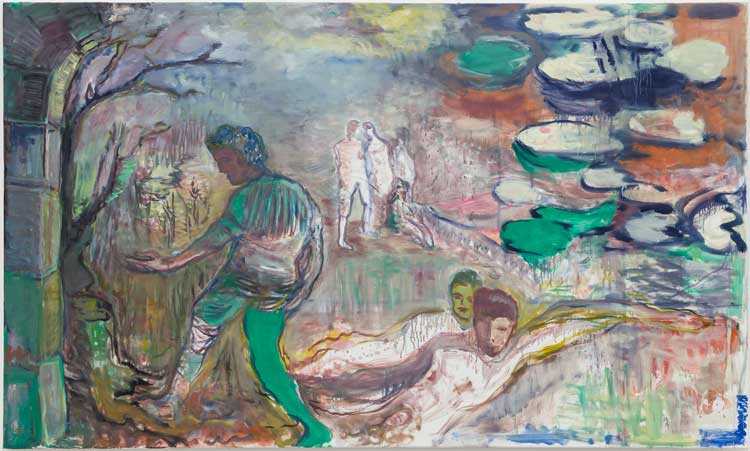
Behrang Karimi. Search of a bird, 2022. Oil on canvas, 120 x 200 cm (47 1/4 x 78 3/4 in). © Behrang Karimi, courtesy Maureen Paley, London. Photo: Mark Blower.
The general feeling of both works is dreamlike, with a lyricism reminiscent of symbolist painting of the late-19th century, except the application of the paint is patchier, laboured in some places, looser in others. This materiality mimics the ungraspable nature of dreams – or the imperfect mental mechanics of piecing together memories of them. To make a more contemporary comparison, these paintings may be compared to Michael Armitage’s dreamlike compositions. Yet Karimi is less overtly political than Armitage, refusing to tell us exactly what is being symbolised because often the symbols are only half-formed, threatening their own dissolution. In this sense, they are more like dreams.
Surface texture plays a significant role, which is especially the case in his smaller works, giving them the quality of reclaimed objects. Something metonymic happens here, as the material sense of reclamation speaks to the workings of memory and myth, and to the understanding that the unconscious and folklore, often entangled and played out in the world of dreams, are interlinked if not inseparable.
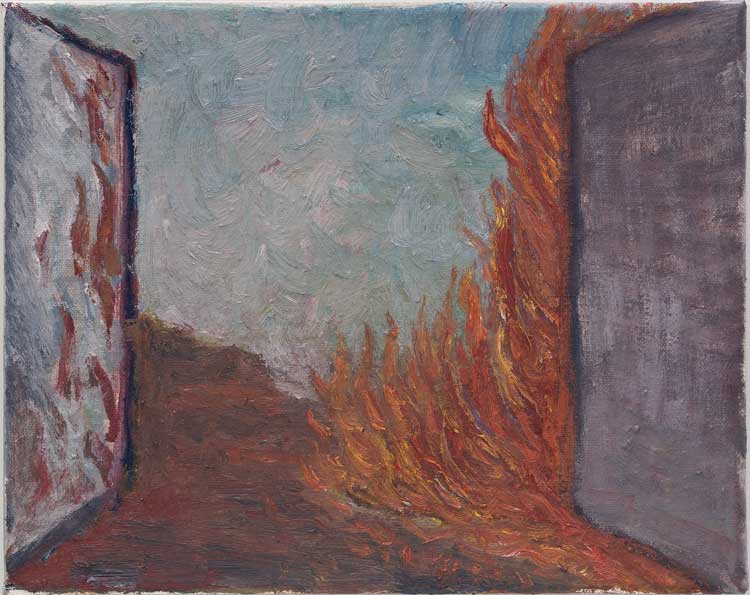
Behrang Karimi. Porta Katharsis, 2022. Oil on canvas, 24 x 30 cm (9 1/2 x 11 3/4 in). © Behrang Karimi, courtesy Maureen Paley, London. Photo: Mark Blower.
Several of these are emblematic in feel, as if there ought to be an accompanying poem or motto (behind the canvas?) encoding their meaning. Many could easily have been dreamed before they were painted. Porta Katharsis and Katharsis (both 2022) both depict fires rushing along the edges of quadrangular doorlike forms. The heavy, mimetic brushwork slows the gaze; we are with the artist labouring over the flames, as if remembering them over and over, trying to decipher them. Behind the railing – on the edge of a balcony or terrace, perhaps – in Katharsis, blueish grey splodges suggest smoke, within which can almost be discerned a howling, purgatorial face. This is not so much the aesthetic or ideology of the dream plundered by the surrealists as the artist’s material engagement with what a dream is. Dreams do not have to be “dreamy”; making sense of them can also be vexing.
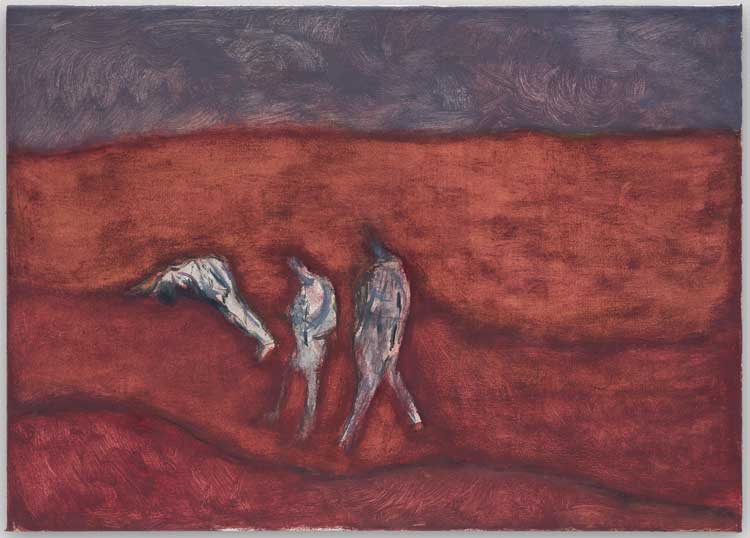
Behrang Karimi. Rettung, 2022. Oil on linen 50 x 70 cm (19 3/4 x 27 1/2 in). © Behrang Karimi, courtesy Maureen Paley, London. Photo: Mark Blower.
The simpler and (seemingly) more ordinary Karimi is, the better. Rettung (2022), whose German title translates as “rescue” or “salvation”, consists of three chalky white figures walking in a landscape of red desert sand, loosely blotched, the dunes or ridges demarcated in dark rough lines that also envelope the figures like shadows. Of one figure, only one leg and part of the torso is visible. Bent double, they seem to be scrambling over a dune, looking for something or having fallen. The other figures are watching, walking past, though one might have stopped. No other clues are given as to what is happening, whether good or bad. The grey sky, which may be the reason for the sand’s deep hue, is foreboding, but this need not pertain to the figures, who are quite comedic. It bears the roughness of a sketch, perhaps laying out a performance work. And yet its multiple, short brushstrokes, often working in different, conflicting directions, ask us to stay with the work, whose agitated surface matters as much as its delineated “action”.
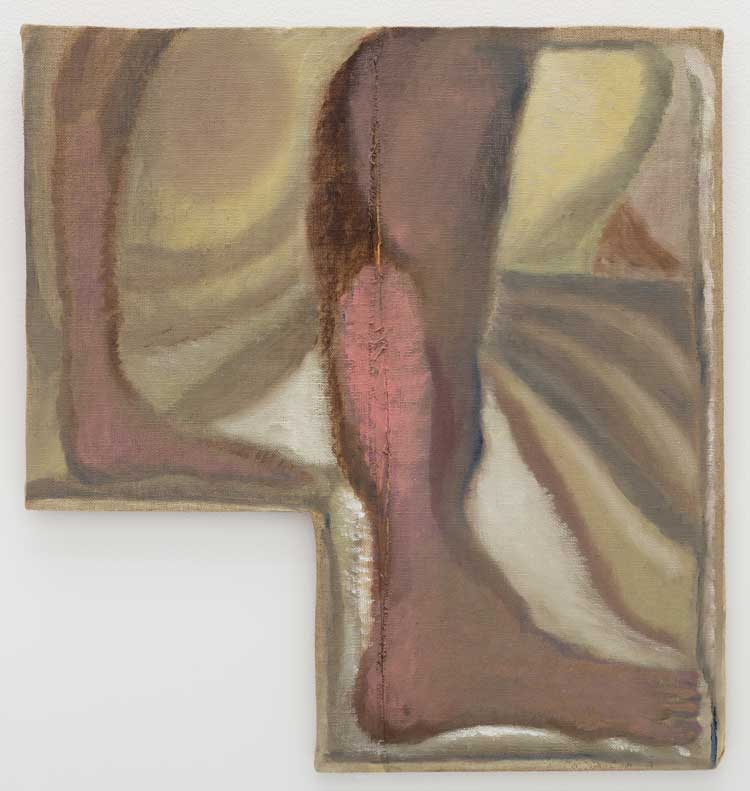
Behrang Karimi. Light Stepper, 2015. Oil on linen mounted on wood 50 x 46 cm (19 3/4 x 18 1/8 in). © Behrang Karimi, courtesy Maureen Paley, London. Photo: Mark Blower.
All but one of the works in Maureen Paley’s smaller space, in Shoreditch, Studio M, are small in scale. Here, Karimi’s most distinguishing traits – fragmentism, unsolvable enigma – are showcased most effectively. At times, metonymy functions not only to bring out the fragmentary nature of consciousness, but also to produce affect. In Light Stepper (2015), the step-shaped canvas is partially ripped down the middle, leaving a sutured scar. The perpendicular line’s relation to the leg is not obviously intended, and yet it elicits pain, giving affective significance to the pink splodge it cuts through.
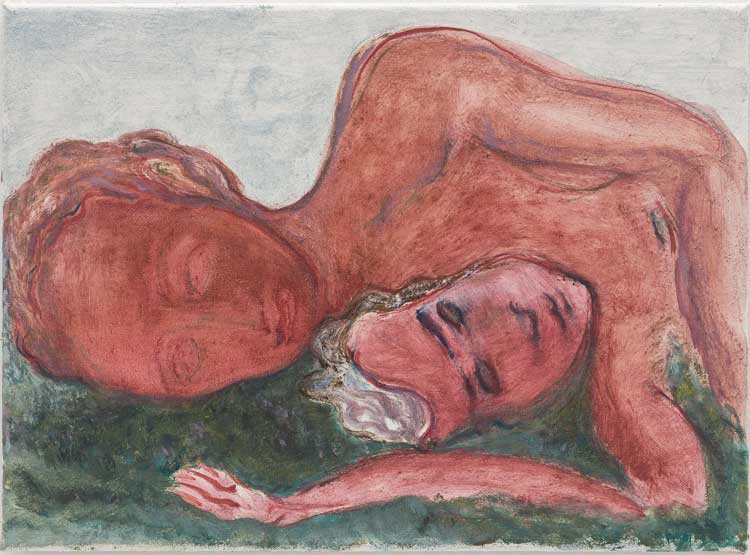
Behrang Karimi. Protectere, 2022. Oil on linen, 33 x 45 cm (13 x 17 3/4 in). © Behrang Karimi, courtesy Maureen Paley, London. Photo: Mark Blower.
On the surface of Protectere (2022), there are tiny pinpricks, to which attention is honed by the smallness of scale and the unevenness of the paint’s application, which highlights the texture of the linen beneath it. Surface becomes skin; we feel the touch between the two figures lying together, a touch that rubs against the idea that they could also be converging into one. o.T. (2022) features a seated woman in profile. The eye catches a fleck of red paint, seemingly contingent – as if it were meant to be mixed with something lighter to create the muted blush that suffuses the rest of the canvas – hovering in the air just in front of her heart. The dot vibrates with an emotion otherwise restrained by her upright comportment, a vibration then felt throughout the painting.
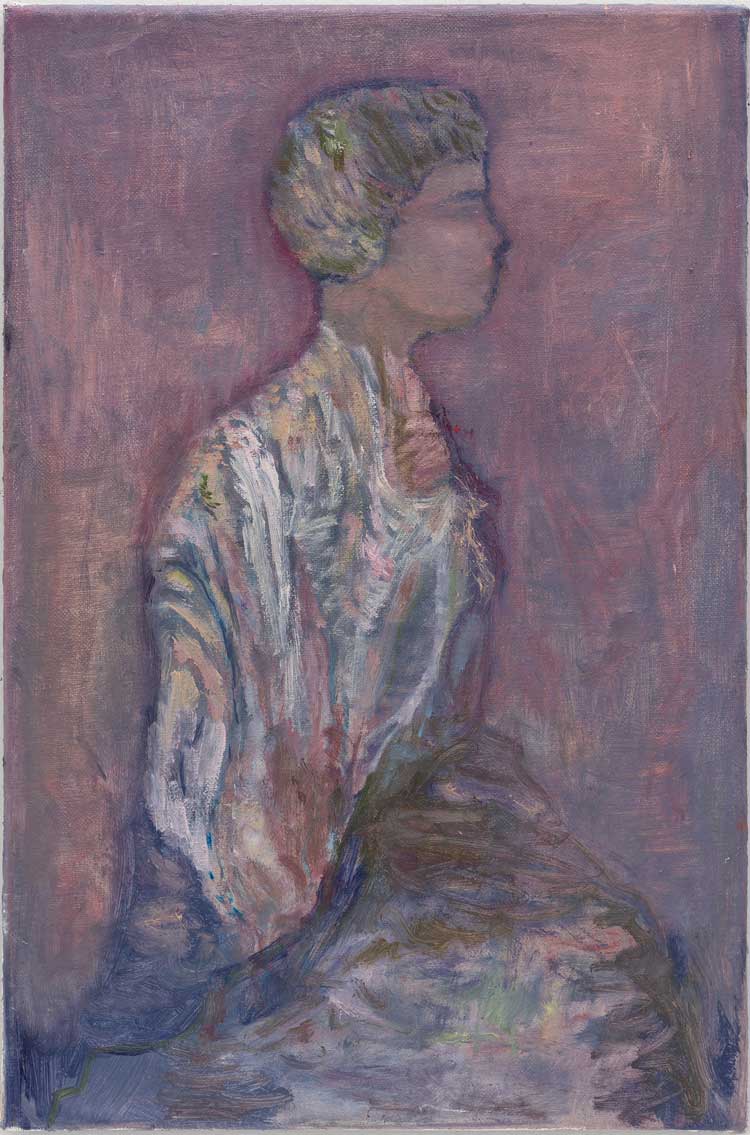
Behrang Karimi. o.T., 2022. Oil on linen, 50 x 33 cm (19 3/4 x 13 in). © Behrang Karimi, courtesy Maureen Paley, London. Photo: Mark Blower.
The stray-like nature of smaller works socialises their materiality – they exist in excess of themselves, as if in motion, their journey happening within and beyond the canvas. Their strange, unresolved psychological tension is absorbing. However, because of their scale, we are also outside them. They hint at the possibility not only of us being absorbed by the image, but also of the object becoming a part of us, as an item on our person, or even a fragment of our own or someone else’s body. For this reason, the larger works are best when they hint at their own potential fragmentation in unobvious ways. It is this uncomfortable fraughtness that sustains the attention, and better distinguishes Karimi as an artist.